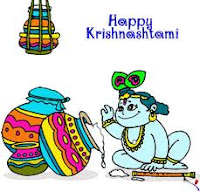Janmaastami
(Krishnaastami)
Krishna Janmashtami (Devanagari कृष्ण जन्माष्टमी kṛṣṇa janmaṣṭami), also known as Krishnashtami, Saatam Aatham, Gokulashtami, Ashtami Rohini, Srikrishna Jayanti, Sree Jayanthi or sometimes merely as Janmashtami, is a Hindu festival celebrating the birth of Krishna, an avatar of the god Vishnu.
 Krishna
Janmashtami is observed on the Ashtami tithi, the eighth day of the
dark half or Krishna Paksha of the month of Shraavana in the Hindu
calendar, when the Rohini Nakshatra is ascendant. The festival
always falls within mid-August to mid-September in the Gregorian calendar.
In 2010, for example, the festival was celebrated on 2 September, and in 2011
on 22 August in North India and on 21 August in South Indian states like
Kerala.
Krishna
Janmashtami is observed on the Ashtami tithi, the eighth day of the
dark half or Krishna Paksha of the month of Shraavana in the Hindu
calendar, when the Rohini Nakshatra is ascendant. The festival
always falls within mid-August to mid-September in the Gregorian calendar.
In 2010, for example, the festival was celebrated on 2 September, and in 2011
on 22 August in North India and on 21 August in South Indian states like
Kerala.
Rasa
lila,
dramatic enactments of the life of Krishna, are a special feature in regions of Mathura
and Vrindavan, and regions following Vaishnavism in Manipur. While
the Rasa lila re-creates the flirtatious aspects of Krishna's
youthful days, the Dahi Handi celebrate God's playful and
mischievous side, where teams of young men form human pyramids to reach a
high-hanging pot of butter and break it. This tradition, also known as uriadi,
is a major event in Tamil Nadu on Gokulashtami.
Janmashtami also known as Gokulashtami marks the
celebration of the birth of Lord Sri Krishna. Sri Krishna was born in the
'Rohini' nakshatram (star) to King Vasudeva and Devaki Devi on the eighth day
of the dark fortnight in the month of Sravana. This festival is also known as
Sri Krishna Jayanti and Krishnashtmi. The actual day of celebration can be on
two different days as the star 'Rohini' and Ashtami may not be on the same day.
These days correspond to the August and September months on the Gregorian
calendar.
Sri Krishna is considered as the eighth avatar (incarnation) of Lord Vishnu's,
(one of three major Hindu Gods) on earth. He is considered to be the Lord's
most glorious incarnations. It is said that his remembrance true heart brings
extreme joy and pleasure because Sri Krishna himself was a manifestation of joy
at all levels and in all walks of life. No other God in the Hindu pantheon, or
for that matter in any other religion, is associated with so many romantic
tales and so fully radiating with all the divine attributes as Sri Krishna.
Since Sri Krishna lived in luxury throughout his life, Sri Krishna Jayanti is
celebrated with pomp and splendor. Plenty of sweets are made on this day. Among
these are laddus (yellu oonde), chakli, cheedai, payasam (kheer), and so on. In
addition, plenty of milk products especially butter, which was Sri Krishna's
favorite childhood food, is given in offerings. A wide variety of fruits are
also offered. The most common sweets made laddus and payasam.
Great indeed are his many Leelas and the way in which he charms one and all.
Several sages and seers have paid homage to him. Narada, Sri Kulashekara
Azhwar, Andal, Tirumangai Azhawar, Nammazhwar have sung glorious verses in
praise of Lord Krishna who embodies Shudda Satvam. The Bhagavad Gita coming
from the Lord is the absolute truth which has withstood the test of time and
has formed the basis and inspiration for many Acharyas and Azhwars.
The life and message of Sri Krishna is the most stirring saga of one of the
greatest saviour and profounder of Dharma. Born in the dungeons of Kansa who
was out to kill him at the very moment of his birth, Sri Krishna's life is
replete with many such mortal dangers which he successfully triumphs over. He
was the unchallenged hero of his times both in terms of his bodily prowess and
his intellectual brilliance.
Sri Krishna Jayanti, therefore, signifies not merely the birth of a great and
Divine teacher of mankind in some distant past but the lighting of the spark of
the Divine Power in every one of us, which spurs us on to play our dynamic part
in this world of practical and hard realities with a sense of high spiritual
purpose. Krishna represents the total power of attraction (Aakarshna Shakti)
like a magnet of infinite rise. Hence Krishna is the source of joy.
The cultural aspects are represented by the traditionally dressed devotees. The
raas or dance is also done with devotees taking part with spiritual fervor. Sri
Krishna who manifests all levels of joy, is also the source of spiritual joy,
which overrides mental or emotional joy, just as emotional joy overrides
physical joy. If all the three are integrated and interdependent, then the
observance of the festival takes on the full meaning of Sri Krishnaarpanamastu
- let everything be offered to Sri Krishna.




